Chapter 10 The nervous system
The nervous system forms mainly from the ectoderm layer, at the beginning of the third week (see Chapter 1), the process known as neurulation. The neural plate forms as a thickening which is widest at its cranial end (Fig. 10.1A). Laterally, the plate edges thicken to form the neural folds (Fig. 10.1B). This is by a process of induction by the underlying notochord and somites. As these neural folds develop they turn towards each other forming the neural groove (Fig. 10.1C), and ultimately fusing as the neural tube. The neural tube structure begins in the cervical region and ends caudally. At the cranial end of the tube the brain develops, whereas the remainder of the tube gives rise to the spinal cord. At each end of the tube are the anterior and posterior neuropores which close in the middle and end of the fourth week respectively (Fig. 10.1D).
In addition to the neuroectoderm cells from which the neurons develop, neural crest cells develop on the edges along the length of the neural folds (Fig. 10.1). These cells detach themselves from the edges of the folds lying beneath the surface ectoderm, and migrate laterally to form a variety of structures. The principal derivatives of neural crest cells are:
Development of the spinal cord (Fig. 10.2A, B)
Most of the length of the neural tube gives rise to the spinal cord. As the wall of the tube thickens it comes to consist of three zones. The innermost is the neuroepithelial (ventricular) layer and, with the mantle layer, it forms the rest of the wall as well as the lining of the central canal of ependymal cells (Fig. 10.2A). The neuroepithelial cells in the mantle layer differentiate to become neuroblasts which will eventually be the neurons of the grey matter. The outermost layer of the developing spinal cord becomes the marginal zone and contains the axons entering and leaving the mantle zone (Fig. 10.2A). After myelination, this layer looks whitish and constitutes the white matter of the spinal cord. There is further development of the mantle zone through differentiation of the neuroblasts forming thickenings in the dorsal and ventral regions of the cord: the alar and basal plates (Fig. 10.2B). The alar plate becomes the sensory region (or dorsal horn) of the grey matter and the basal plate becomes the motor region (ventral horn). The lumen of the neural tube in the region of the spinal cord becomes diamond shaped. The pointed dorsal aspect of the tube is the roof plate, whilst the floor plate lies at the opposite pole. Dividing the alar and basal plates is the sulcus limitans, a groove. The neurons in the ventral horn give rise to axons that enter the ventral roots. The sensory bipolar neurons in the dorsal root ganglia give rise to axons that enter at the dorsal roots synapsing with perikarya (neuronal cell bodies) in the dorsal horns.
Development of the brain
At the cranial end of the tube three dilations develop during the fourth week, the primary brain vesicles (the prosencephalon, the mesencephalon and the rhombencephalon; Fig. 10.3). They are also known respectively as the forebrain, midbrain and hindbrain. Mainly because of the limited space in which the cranial end of the neural tube is forming there is insufficient space for the lengthening tube. It thus has to bend, and does so in two places: the cervical and cephalic flexures. The former lies between the rhombencephalon and spinal cord, whereas the latter lies in the region of the mesencephalon (Fig. 10.4B).
The three primary vesicles develop into five secondary vesicles by the fifth week. The prosencephalon becomes the telencephalon and the diencephalon. The telencephalon has bilateral portions which become the two cerebral hemispheres. The diencephalon becomes the thalamus and hypothalamus. The rhombencephalon comprises two regions, separated by the pontine flexure: the metencephalon and the myelencephalon (Fig. 10.4B). The metencephalon becomes the pons and cerebellum, and the myelencephalon gives rise to the medulla.
The lumen of the neural tube becomes the ventricular system in the region of the brain and brainstem, and the central canal in the spinal cord. The part of the ventricular system lying within the rhombencephalon becomes the fourth ventricle, and that in the diencephalon becomes the third ventricle (Fig. 10.3B). The part of the neural tube lumen between the lateral ventricles and the third ventricle is the interventricular foramen and between the third and the fourth ventricle is the cerebral aqueduct, which is continuous with the central canal of the spinal cord.
Neural tube defects
Abnormal closure of the neural tube may occur, especially between the third and fourth weeks, and results in a range of anomalies known as spina bifida. This relates to the usual finding of a divided vertebral arch, which is present in all cases of spina bifida. Other changes may involve the underlying neural tube tissue. The clinical problems with spina bifida include problems with lower limb movements, and control of bowel and bladder function. Spina bifida occulta is the form where there is a divided vertebral arch, but no other abnormality (Fig. 10.5A). Often in such cases the site of the abnormality is marked by a tuft of hairy skin. In the more serious case of spina bifida cystica, neural tissues and their coverings protrude through the vertebral arches and skin, forming cyst-like arrangements. There are two types: meningocoele, where the neural tube lies in its normal position, with a cyst formed by the protruding subarachnoid space (Fig. 10.5B), or meningomyelocoele, in which the neural tube lies ectopically within the cystic space (Fig. 10.5C). Spina bifida cystica is often associated with hydrocephalus. More rarely, the neural folds do not round up but remain as folds continuous with the surface ectoderm, with no lumen for the neural tube. In this type of spina bifida, the neural tube tissue is exposed and folded, and is known as rachischisis (Fig. 10.5D).
Formation of the pituitary gland
The pituitary gland develops from two sources: a downgrowth from the floor of the diencephalon (or infundibulum), and an upgrowth from the stomodaeum (the ectodermal portion of the oral cavity) known as Rathke’s pouch (Fig. 10.6). At about the third week Rathke’s pouch appears as an evagination growing towards the infundibulum. By 8 weeks the pouch loses its connection with the oral cavity, and lies immediately adjacent to the infundibulum (Fig. 10.6). Thus the pituitary gland has two components: a posterior part derived from the diencephalon with which it is in direct communication, and an anterior part derived from the oral cavity. These two parts are known as the neurohypophysis and the adenohypophysis respectively.
 The nervous system develops from ectoderm at the start of the third week, initially as neural folds which then close to form the neural tube in the process known as neurulation.
The nervous system develops from ectoderm at the start of the third week, initially as neural folds which then close to form the neural tube in the process known as neurulation. The neural crest detaches from the folds, and disseminates widely to contribute to a range of structures throughout the body.
The neural crest detaches from the folds, and disseminates widely to contribute to a range of structures throughout the body. The spinal cord develops initially as three layers: the neuroepithelial layer, the mantle layer and the marginal zone.
The spinal cord develops initially as three layers: the neuroepithelial layer, the mantle layer and the marginal zone. The neuroepithelial layer becomes the ependymal layer, the mantle layer forms the neuroblasts that will become the neurons of the grey matter and the white matter contains the axons.
The neuroepithelial layer becomes the ependymal layer, the mantle layer forms the neuroblasts that will become the neurons of the grey matter and the white matter contains the axons. Further development of the mantle zone gives rise to the alar and basal plates, the sensory and motor regions of the spinal cord.
Further development of the mantle zone gives rise to the alar and basal plates, the sensory and motor regions of the spinal cord. The cranial end of the neural tube gives rise to three primary brain vesicles: the prosencephalon, the mesencephalon and the rhombencephalon. They become the five secondary vesicles: the telencephalon, the diencephalon, the mesencephalon, the metencephalon and the myelencephalon respectively.
The cranial end of the neural tube gives rise to three primary brain vesicles: the prosencephalon, the mesencephalon and the rhombencephalon. They become the five secondary vesicles: the telencephalon, the diencephalon, the mesencephalon, the metencephalon and the myelencephalon respectively.
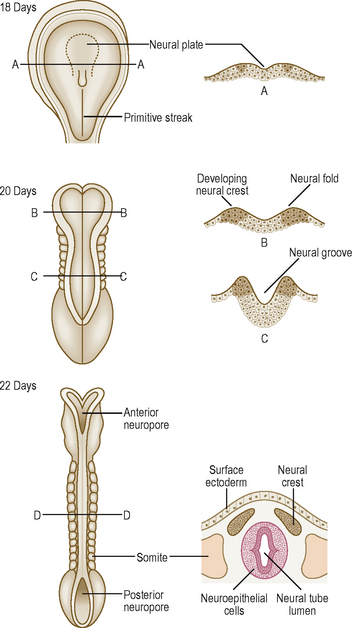







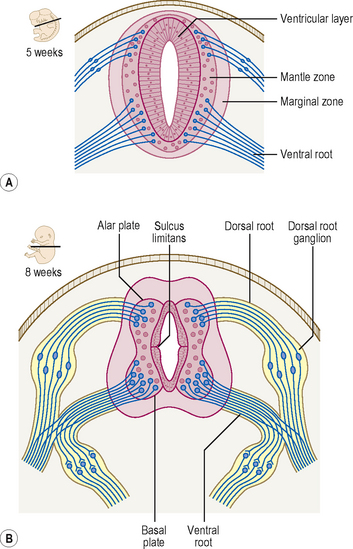
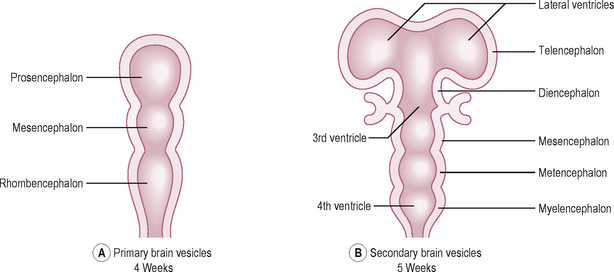
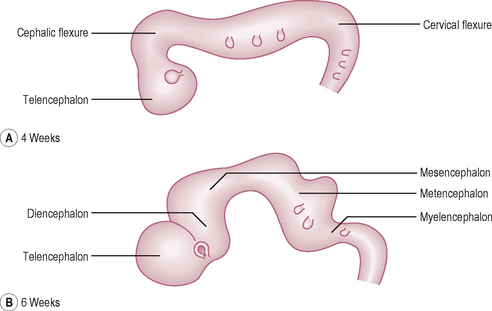
 Clinical box
Clinical box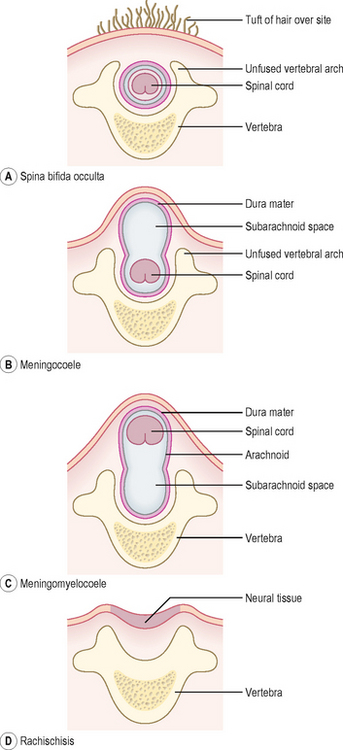

 Clinical box
Clinical box

